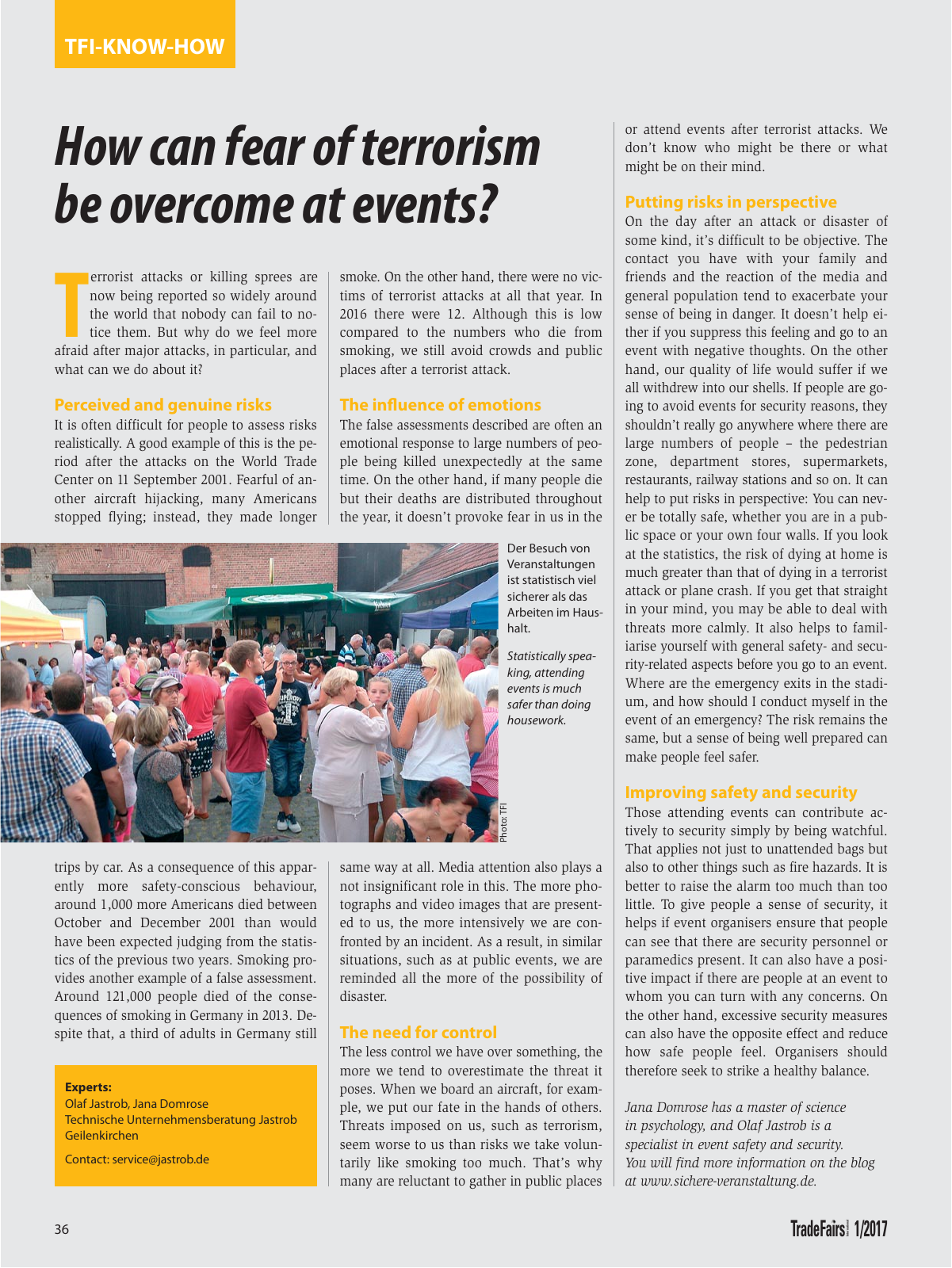T errorist attacks or killing sprees are now being reported so widely around the world that nobody can fail to no tice them But why do we feel more afraid after major attacks in particular and what can we do about it Perceived and genuine risks It is often difficult for people to assess risks realistically A good example of this is the pe riod after the attacks on the World Trade Center on 11 September 2001 Fearful of an other aircraft hijacking many Americans stopped flying instead they made longer trips by car As a consequence of this appar ently more safety conscious behaviour around 1 000 more Americans died between October and December 2001 than would have been expected judging from the statis tics of the previous two years Smoking pro vides another example of a false assessment Around 121 000 people died of the conse quences of smoking in Germany in 2013 De spite that a third of adults in Germany still smoke On the other hand there were no vic tims of terrorist attacks at all that year In 2016 there were 12 Although this is low compared to the numbers who die from smoking we still avoid crowds and public places after a terrorist attack The influence of emotions The false assessments described are often an emotional response to large numbers of peo ple being killed unexpectedly at the same time On the other hand if many people die but their deaths are distributed throughout the year it doesn t provoke fear in us in the same way at all Media attention also plays a not insignificant role in this The more pho tographs and video images that are present ed to us the more intensively we are con fronted by an incident As a result in similar situations such as at public events we are reminded all the more of the possibility of disaster The need for control The less control we have over something the more we tend to overestimate the threat it poses When we board an aircraft for exam ple we put our fate in the hands of others Threats imposed on us such as terrorism seem worse to us than risks we take volun tarily like smoking too much That s why many are reluctant to gather in public places or attend events after terrorist attacks We don t know who might be there or what might be on their mind Putting risks in perspective On the day after an attack or disaster of some kind it s difficult to be objective The contact you have with your family and friends and the reaction of the media and general population tend to exacerbate your sense of being in danger It doesn t help ei ther if you suppress this feeling and go to an event with negative thoughts On the other hand our quality of life would suffer if we all withdrew into our shells If people are go ing to avoid events for security reasons they shouldn t really go anywhere where there are large numbers of people the pedestrian zone department stores supermarkets restaurants railway stations and so on It can help to put risks in perspective You can nev er be totally safe whether you are in a pub lic space or your own four walls If you look at the statistics the risk of dying at home is much greater than that of dying in a terrorist attack or plane crash If you get that straight in your mind you may be able to deal with threats more calmly It also helps to famil iarise yourself with general safety and secu rity related aspects before you go to an event Where are the emergency exits in the stadi um and how should I conduct myself in the event of an emergency The risk remains the same but a sense of being well prepared can make people feel safer Improving safety and security Those attending events can contribute ac tively to security simply by being watchful That applies not just to unattended bags but also to other things such as fire hazards It is better to raise the alarm too much than too little To give people a sense of security it helps if event organisers ensure that people can see that there are security personnel or paramedics present It can also have a posi tive impact if there are people at an event to whom you can turn with any concerns On the other hand excessive security measures can also have the opposite effect and reduce how safe people feel Organisers should therefore seek to strike a healthy balance Jana Domrose has a master of science in psychology and Olaf Jastrob is a specialist in event safety and security You will find more information on the blog at www sichere veranstaltung de 36 TradeFairs Internation al 1 2017 TFI KNOW HOW How can fear of terrorism be overcome at events Experts Olaf Jastrob Jana Domrose Technische Unternehmensberatung Jastrob Geilenkirchen Contact service jastrob de Der Besuch von Veranstaltungen ist statistisch viel sicherer als das Arbeiten im Haus halt Statistically spea king attending events is much safer than doing housework Ph ot o T FI

Hinweis: Dies ist eine maschinenlesbare No-Flash Ansicht.
Klicken Sie hier um zur Online-Version zu gelangen.
Klicken Sie hier um zur Online-Version zu gelangen.